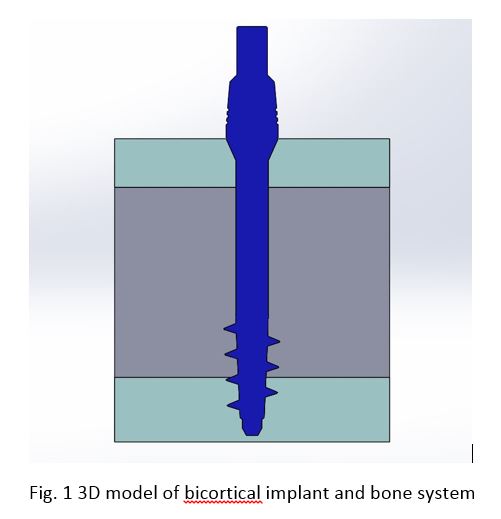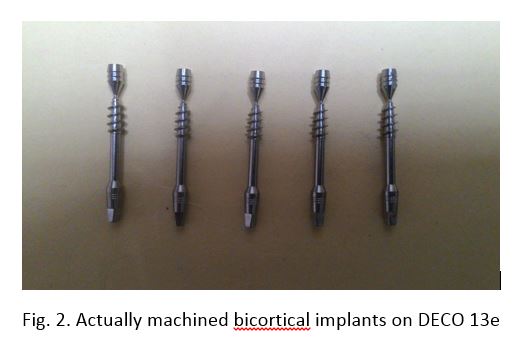Introduction: Bicortical dental implants are used to get primary stability using both the cortex [1]. The purpose of this article is to present finite element modelling as well as experimental results of bicortical dental implant screws with varying geometrical designs subjected to tension, compression and torsion.
Materials and Methods: Finite element models are generated using the geometries of prevailing bicortical implants thread profiles like BCS, KOS and their variation in stress by varying the implant length, root diameter, thread depth, helix angle, pitch in the three dimensional FEM model under study.(Figure 1)

The implants are subjected to tension, compression as well as torsional loads both experimentally and by simulation on sandwiched Sawbone blocks having 2mm FRP laminates on both the sides mimicking cortical bone of the mandible or maxilla with varying density of core inside mimicking the trabeculae. Kistler dynamometer is used to measure the resistance and torsional forces during insertion and pullout. Material used for the implants is titanium alloy Ti6Al4V. The implants are machined on a sliding stock, ten axis Swiss CNC machine TORNOS DECO 13e. Whirling attachment with special whirling tools is used to manufacture BCS and KOS thread profiles of different pitch, depth of thread and helix angle. (Figure 2)

Results: Thread design parameters are varied for given loads of 450N tension, 450N compression and 1000Nmm torsional loads. Von Misses stress at various section of implants are measured for different combinations of thread design parameters. In the bone, stresses are calculated at cortico crestal, cortico cancellous, cancellous and basal cortical regions. In the implant stresses are calculated for crestal, middle and apical region. Maximum stress levels are found to be at the cortico-cancellous region. Stability of anchorage is analysed for different implant parameters.
Discussion: Bicortical implant are fast and safe because of their immediate loading, basal/cortical bone support, and extremely low failure rates [2]. The article presents detailed FE analysis and experimental results to arrive at optimum design parameters for its future development. Analysis indicates that as the basal threads provides maximum anchorage to the implant, maximum stresses in implant and adjoining bones are observed in the cortico-cancellous interface in the crestal level only.
Conclusions: Similar to the standard threaded implants, maximum stresses occur at crestal region, in case of bicortical implants along with a share of maximum stress at basal region also for instant loading and thereby limiting micro motions. The study provides the basis for improved geometrical design parameters of a bicortical dental implant design for future modifications and new implant development.
Council of Scientific and Industrial Research (CSIR); New Millennium Indian Technology Leadership Initiative (NMITLI)
References:
[1] F. Lofaj, J. Kučera, D. Németh, L. Kvetková, Finite element analysis of stress distributions in mono- and bi-cortical dental implants, Materials Science and Engineering: C, Volume 50, 1 May 2015, Pages 85-96, ISSN 0928-4931, http://dx.doi.org/10.1016/j.msec.2015.01.095.
[2] Stefan Ihde, Tomas Goldmann, Lucie Himmlova, Zoran Aleksic, The use of finite element analysis to model bone-implant contact with basal implants, Oral Surgery, Oral Medicine, Oral Pathology, Oral Radiology, and Endodontology, Volume 106, Issue 1, July 2008, Pages 39-48, ISSN 1079-2104,